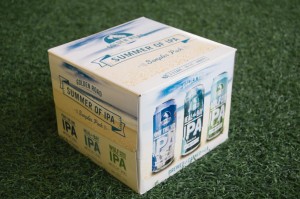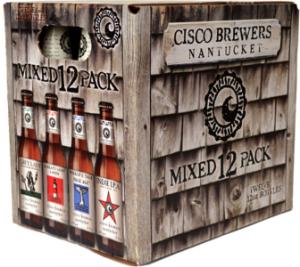
Now, rather than strive for the complete brand allegiance exhibited by yesterday’s drinkers, an increasing number of craft breweries are making the effort to appeal to the more uninhibited sensibilities of today’s. And it’s working.
In the 52 weeks ending March 24, the craft variety 12-pack was up 22 percent by volume over the year prior, according to IRI. More than 5.2 million cases landed on and left shelves across multi-outlet and convenience channels. Behind the ever-dominant IPA, the seasonal, and the pale ale, variety packs also round out the top four most popular “styles” in IRI’s craft universe, with a 7.7 percent dollar share of the segment, according to the Brewers Association.
Across the country, retailers seem to be carving out more space to accommodate the growing trend of variety packs and brewers are heeding the call with offerings fit for any occasion, despite the additional labor and costs inherent in cramming three or four different brands into one box.
Golden Road Brewing, the Los Angeles, Calif.-based craft brewery that opened its doors in October 2011, is one of the fastest growing new companies in the craft segment, projecting 30,000 barrels for this, its third year. The brewery has also just announced its launch into the mixed pack space with a 9-pack of three different IPAs in 16-oz. cans (the total liquid volume — 144 oz. — is equivalent to that of a traditional 12-pack in 12-oz. bottles or cans).
Meg Gill, the brewery’s co-founder, said exploring the space is a necessary means of keeping up with the Joneses as it were.
“The retailers are strongly demanding that the brewers go with some mixed packs to get that shelf demand,” she said. “It’s gotten to a point of competition now where it doesn’t matter if your 6-pack flagship is selling great.”
This rising demand, she said, is a simple result of the evolving palate of the consumer that wants more flavors for their money.
“We go to small plate restaurants and get six different things for the table,” she said. “I think the same thing is true with beer. We don’t want three or four of the same beers. We want to try a bunch of different beers depending on the occasion.”
And the occasion is key. As a concept, it’s broad; cans, for instance, are better suited for a day at the beach or a ride in the boat. But by nature, mixed packs meet the needs, at the very least, of more than one occasion, which is becoming paramount as more and more breweries flood the market.
Bob Sullivan, vice president of specialty and craft brands at Andrews Distributing in Dallas, Texas, said a brewery is incapable of owning a market until their brands serve as the foremost brews for any occasion.
“You own your home market when you can provide your loyal consumer with your beer for every single beer buying occasion,” he said. “You do not want a beer drinking occasion where someone buys someone else’s beer because you’re too conservative.”
Though it would be easy, especially for smaller operations, to shy away from the packaging, as it is more costly, both in terms of dollars and manpower, more are letting their conservative tendencies fall by the wayside in favor of trying to grab as many of those coveted beer drinking occasions as possible.
Added Gill, “It’s extra labor for everybody, even the big guysÔǪ [But] there’s enough retailer demand to make the investment.”
And some of these variety packs make even more sense rudimentarily than the basic supply and demand concept.
Stevens Point Brewery, one of the nation’s oldest, based in Stevens Point, Wis., just announced its very first IPA variety pack (though it has released other mixed packs). See if you can follow this arithmetic from Joe Martino, brewery operating partner:
“It’s taking the number one style, the IPA, and the number four grouping of styles,” he said. “I thought we were right on target.”
So did Shipyard Brewing, and Sierra Nevada, both of which recently launched IPA variety packs of their own — the latter the brewery’s first foray into mixed packs in its 34-year history.
It all comes back to the same basic principle of giving the consumer more, said Mike Sheehan, brand manager for Cisco, which recently introduced its first mixed pack.

Rob Hill, who coordinates new programs at Total Wine & More and is a Certified Cicerone added that brewers are using the package as a marketing tool, as well.
“Brewers have also astutely used their variety packs as a method for putting into the market some experimental brews or lower volume small batch brews that aren’t available otherwise,” he said. “The brewers, based on that feedback might decide, ‘Hey, this beer is a good chance of being successful if we put it out in its own 6-pack.’ It lowers the risk for the brewers to sort of market test some of their creations.”
“Consumers don’t look at that generally as a marketing trick or scheme,” he added. “They love it, it’s exciting.”
So will retailers continue to dedicate more shelf space to craft multi-packs? Sullivan thinks so.
From him, the growth of the package is sustainable as long as brewers remain innovative in how they offer variety packs. To that end, he called Sierra Nevada’s Beer Camp Across America pack — a collaboration project between the Chico, Calif.-based brewery and 12 others from across the country — “the ultimate” in the space right now.
“Lots of people are familiar with the 12-pack sampler, but this is unprecedented,” said Joey Redner, founder and CEO of Cigar City Brewing of Tampa Bay, Florida in a promotional video for the project (seen below)
The Beer Camp Across America 12-pack consists of 10 bottles and two cans, of all different styles made by 12 different breweries in collaboration with Sierra Nevada.
Added Hill, if brewers build it, and keep things fresh and innovative the way Sierra has, they — distributors, retailers and consumers — will come.
“When it comes to craft beer, in whatever package, we’re carving out more and more space all the time,” he said. “It’s really been a win.”
